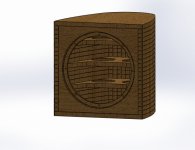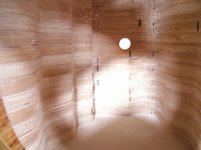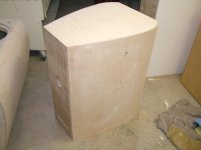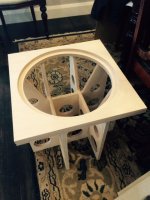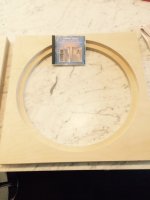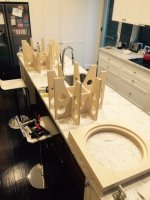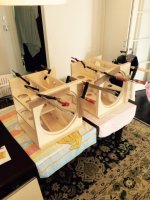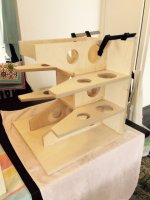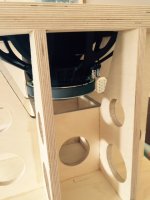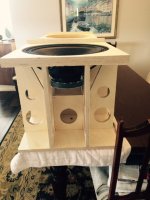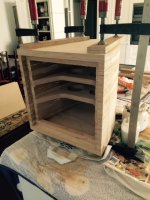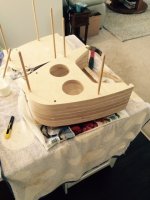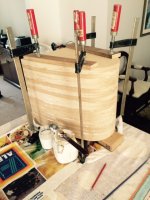Mid bass CAD and bass unit CAD underway.
Looks very similar to the Vapor Audio Arcus translam design for the TPL-150H + Lambda TD10M.
Do you have other 3D-CAD which pushes translam technology farther?
Large radius on sides+top front edges to reduce diffraction.
Rear exponential taper'ed volume behind the M to remove internal resonances.
Reduced vibration.... slots for sand? baffle isolation? Magnet Support?
Looks very similar to the Vapor Audio Arcus translam design for the TPL-150H + Lambda TD10M.
Do you have other 3D-CAD which pushes translam technology farther?
Large radius on sides+top front edges to reduce diffraction.
Rear exponential taper'ed volume behind the M to remove internal resonances.
Reduced vibration.... slots for sand? baffle isolation? Magnet Support?
No, not really. But will hone the design as I go. I don't want to copy others, I'm my own designer. Already, the units will be over engineered, with the thick Birch Ply.
baffle isolation? Magnet Support?
What do you mean by these and how are they beneficia?
Birch plywood vertical stack cabinet construction
Stacking Birch plywood is a great way to build non resonant beautiful looking cabinets, but be prepared for extra costs if you want a high end paint or veneer finish....I had to clad mine in curved ply to avoid the joins showing through the painted sides.
Nowadays its popular to just leave the raw stack construction visible so its much cheaper....just sanding and varnish and your good to go.
I cant tell from your render, but its good to make the interior curved / wavy asymmetric / to help break up internal reflections and standing waves.
Good luck and hope your customer appreciates all your hard work!
Cheers
Derek.
Baffle made in CAD....buying the ply shortly.
Stacking Birch plywood is a great way to build non resonant beautiful looking cabinets, but be prepared for extra costs if you want a high end paint or veneer finish....I had to clad mine in curved ply to avoid the joins showing through the painted sides.
Nowadays its popular to just leave the raw stack construction visible so its much cheaper....just sanding and varnish and your good to go.
I cant tell from your render, but its good to make the interior curved / wavy asymmetric / to help break up internal reflections and standing waves.
Good luck and hope your customer appreciates all your hard work!
Cheers
Derek.
Attachments
thanks DerekStacking Birch plywood is a great way to build non resonant beautiful looking cabinets, but be prepared for extra costs if you want a high end paint or veneer finish....I had to clad mine in curved ply to avoid the joins showing through the painted sides.
Nowadays its popular to just leave the raw stack construction visible so its much cheaper....just sanding and varnish and your good to go.
I cant tell from your render, but its good to make the interior curved / wavy asymmetric / to help break up internal reflections and standing waves.
Good luck and hope your customer appreciates all your hard work!
Cheers
Derek.
I'll keep the ply exposed.
The rear of the mid bass has wavy pattern, the sides taper in (non parallel).
Regards
Andrew
More pics. Someone asked about my goals/objectives. I wrote this:
Mark, thank you for your thoughtful questions.
I call this project a "world beater", not to be arrogant...but to take the best components around to create a reasonable in-room speaker. (You could build better, but there are comprises re cost and size.)
Bass is critical. So I have opted for a large driver...but want to add effieciency...hence, pro driver like Faital Pro. With the efficiency of 96Db, these will provide suitable bass depth...but importantly, detail/speed. I don't want "home theatre sounding" bass. There's a place for HT bass....but that is different to stero/music listening.
Mid bass is critical also....and a suitable match to the bass and tweeter is hard. A 12 or 15 inch comes into play when trying to tie these ends together. With a pro driver like FP or Beyma, you can marry the two extremes. The chosen 12 inch Beyma will comfortably cross over well within the 18 inch upper region...and will naturally cross over higher than where the Beyma tweeter well exend. Meaning, all the components are operating well within their comfort zone.
As such, the entite system will operate with minimal power (efficiency)...which means quality valve or Class A amps will make this sound equisite.
Sure, a $80,000 Wilson will sound fantastic...but you need $40,000 of amplification to drive their 87dB systems. My goal is use 15 watts. (However, to make things easier, I add 800 watts per channel for the bass modules, which is over engineering in the extreme.)
With active bass, it is therefore easy to tune this to the room. Bass is the hardest to get right, hence Minidsp.
I will involve Henry (Redefy Audio) to test my components and to build the best passive xover for the mid and HF.
A world beater? Hard to know. Levinson charges USD$100,000 for his version.....I'm running about 15% of that.....!
Does this help?
Andrew
Mark, thank you for your thoughtful questions.
I call this project a "world beater", not to be arrogant...but to take the best components around to create a reasonable in-room speaker. (You could build better, but there are comprises re cost and size.)
Bass is critical. So I have opted for a large driver...but want to add effieciency...hence, pro driver like Faital Pro. With the efficiency of 96Db, these will provide suitable bass depth...but importantly, detail/speed. I don't want "home theatre sounding" bass. There's a place for HT bass....but that is different to stero/music listening.
Mid bass is critical also....and a suitable match to the bass and tweeter is hard. A 12 or 15 inch comes into play when trying to tie these ends together. With a pro driver like FP or Beyma, you can marry the two extremes. The chosen 12 inch Beyma will comfortably cross over well within the 18 inch upper region...and will naturally cross over higher than where the Beyma tweeter well exend. Meaning, all the components are operating well within their comfort zone.
As such, the entite system will operate with minimal power (efficiency)...which means quality valve or Class A amps will make this sound equisite.
Sure, a $80,000 Wilson will sound fantastic...but you need $40,000 of amplification to drive their 87dB systems. My goal is use 15 watts. (However, to make things easier, I add 800 watts per channel for the bass modules, which is over engineering in the extreme.)
With active bass, it is therefore easy to tune this to the room. Bass is the hardest to get right, hence Minidsp.
I will involve Henry (Redefy Audio) to test my components and to build the best passive xover for the mid and HF.
A world beater? Hard to know. Levinson charges USD$100,000 for his version.....I'm running about 15% of that.....!
Does this help?
Andrew
Attachments
More pics. Someone asked about my goals/objectives. I wrote this:
Mark, thank you for your thoughtful questions.
I call this project a "world beater", not to be arrogant...but to take the best components around to create a reasonable in-room speaker. (You could build better, but there are comprises re cost and size.)
Bass is critical. So I have opted for a large driver...but want to add effieciency...hence, pro driver like Faital Pro. With the efficiency of 96Db, these will provide suitable bass depth...but importantly, detail/speed. I don't want "home theatre sounding" bass. There's a place for HT bass....but that is different to stero/music listening.
Mid bass is critical also....and a suitable match to the bass and tweeter is hard. A 12 or 15 inch comes into play when trying to tie these ends together. With a pro driver like FP or Beyma, you can marry the two extremes. The chosen 12 inch Beyma will comfortably cross over well within the 18 inch upper region...and will naturally cross over higher than where the Beyma tweeter well exend. Meaning, all the components are operating well within their comfort zone.
As such, the entite system will operate with minimal power (efficiency)...which means quality valve or Class A amps will make this sound equisite.
Sure, a $80,000 Wilson will sound fantastic...but you need $40,000 of amplification to drive their 87dB systems. My goal is use 15 watts. (However, to make things easier, I add 800 watts per channel for the bass modules, which is over engineering in the extreme.)
With active bass, it is therefore easy to tune this to the room. Bass is the hardest to get right, hence Minidsp.
I will involve Henry (Redefy Audio) to test my components and to build the best passive xover for the mid and HF.
A world beater? Hard to know. Levinson charges USD$100,000 for his version.....I'm running about 15% of that.....!
Does this help?
Andrew
Hello Andrew.
I'm following this thread with great interest. I don't have nearly as much experience as you building speakers, but I'm building a system that shares a number of points with yours. Also meant for music only, and SETs. Commonalities Such as the TPL-150H on top, bass drivers in their own enclosure with their own amplification and DSP. The midrange you are using is in the cards, but I'm concerned with beaming/directivity match. How low are you planning to cross over to the TPL? I'm shooting for 2-2.5kHz.
Your bass cabinets are looking great. Are these sealed? What Qtc did you design the for? I'll run stereo subs up to 80Hz and dual sealed 10" Beymas 10G40 from 80 to about 400Hz. I'm shooting for Qtc of 0.71 for the sealed Beymas but it's coming back as a very small enclosure.
Hi all,
Similarly looking with great interest at this. Made a pair of DQWT's some time ago but needed a pair of efficient loudspeakers to go loud. I had very similar ideas of using the TPL150h/TPL200h 12p80nd and then active bass. It seems in the uk that the 18p80nd is no longer listed in some of the suppliers websites. I was wondering if there was anyone who could help me with a crossover design for the TPL and the mid bass. I intend to use a hypex module to power the bass and an active crossover to split the 2 sections. Speakers will be used in a 7x4.5m room so cabinet size is not really an issue.
All advice/information gratefully appreciated.
Dean
Similarly looking with great interest at this. Made a pair of DQWT's some time ago but needed a pair of efficient loudspeakers to go loud. I had very similar ideas of using the TPL150h/TPL200h 12p80nd and then active bass. It seems in the uk that the 18p80nd is no longer listed in some of the suppliers websites. I was wondering if there was anyone who could help me with a crossover design for the TPL and the mid bass. I intend to use a hypex module to power the bass and an active crossover to split the 2 sections. Speakers will be used in a 7x4.5m room so cabinet size is not really an issue.
All advice/information gratefully appreciated.
Dean
Hello Andrew.
I'm following this thread with great interest. I don't have nearly as much experience as you building speakers, but I'm building a system that shares a number of points with yours. Also meant for music only, and SETs. Commonalities Such as the TPL-150H on top, bass drivers in their own enclosure with their own amplification and DSP. The midrange you are using is in the cards, but I'm concerned with beaming/directivity match. How low are you planning to cross over to the TPL? I'm shooting for 2-2.5kHz.
Your bass cabinets are looking great. Are these sealed? What Qtc did you design the for? I'll run stereo subs up to 80Hz and dual sealed 10" Beymas 10G40 from 80 to about 400Hz. I'm shooting for Qtc of 0.71 for the sealed Beymas but it's coming back as a very small enclosure.
Thanks. Im note sure I went that far in my planning re setting the Qtc.
The driver specs for the FP 18 provide ample overlap with the Beyma 12. We'll probably go with 200-300Hz.
The subs are sealed to avoid complexitiy with porting/chuffing. It's a bit academic, as the driver is so efficient, plus we will use 800 watts/side amp.
Mid bass starting to be glued up tonight.
Attachments
Thanks. Im note sure I went that far in my planning re setting the Qtc.
The driver specs for the FP 18 provide ample overlap with the Beyma 12. We'll probably go with 200-300Hz.
The subs are sealed to avoid complexitiy with porting/chuffing. It's a bit academic, as the driver is so efficient, plus we will use 800 watts/side amp.
Mid bass starting to be glued up tonight.
That is looking good.
Interesting you don't look into Qtc. How do you determine the volume of the sealed box you need? My understanding is the box Qtc, for a given driver, and in a sealed box, will determine the low-end extension/decay slope and the transient behavior (under/over damped). But you are experienced and not looking at Qtc so maybe there is a different approach to it? Very relevant to me as I'm heading towards a sealed translam 80-400Hz box construction now. My subs are sealed too.
Sealed box, Qtc, extension, max SPL and quality.....Juggle!
Hi Lewinski,
I am sure Andrew has his own views and ideas and he certainly knows what he is doing so you can be sure there is a good reason for doing it his way!
I have made a few enemies on this site because I am dead against ports, transmission lines, back loaded horns or any form of delayed resonance systems.....For me its got to be VPL open baffle or sealed.
To answer your question as best I can hear is how I work out my sealed box sub volume / performance.
Take a good 15 inch Pro driver ( Beyma , Precision Devices, 18 Sound etc) with a good 4 or 5 inch single layer voice coil, look for a low Qts and Qts, good Xmax (8mm to 10mm will do) and a powerful motor ( Bl 20 to 25) and you are done....The rest is just a big amp and good Eq.
Exact box volume is almost irrelevant, well more a by product of the Qtc you want.
I use AJ Design Software - Math Science Engineering Finance Physics Health Calculators Apps as a quick guide to sort out the best driver candidates then detailed sims and finally build and test.
I have attached a sim of a 12 inch sub and I will dig out and post another one of a 15 inch sub.
Hope this helps and all the best
Derek.
The
That is looking good.
Interesting you don't look into Qtc. How do you determine the volume of the sealed box you need? My understanding is the box Qtc, for a given driver, and in a sealed box, will determine the low-end extension/decay slope and the transient behavior (under/over damped). But you are experienced and not looking at Qtc so maybe there is a different approach to it? Very relevant to me as I'm heading towards a sealed translam 80-400Hz box construction now. My subs are sealed too.
Hi Lewinski,
I am sure Andrew has his own views and ideas and he certainly knows what he is doing so you can be sure there is a good reason for doing it his way!
I have made a few enemies on this site because I am dead against ports, transmission lines, back loaded horns or any form of delayed resonance systems.....For me its got to be VPL open baffle or sealed.
To answer your question as best I can hear is how I work out my sealed box sub volume / performance.
Take a good 15 inch Pro driver ( Beyma , Precision Devices, 18 Sound etc) with a good 4 or 5 inch single layer voice coil, look for a low Qts and Qts, good Xmax (8mm to 10mm will do) and a powerful motor ( Bl 20 to 25) and you are done....The rest is just a big amp and good Eq.
Exact box volume is almost irrelevant, well more a by product of the Qtc you want.
I use AJ Design Software - Math Science Engineering Finance Physics Health Calculators Apps as a quick guide to sort out the best driver candidates then detailed sims and finally build and test.
I have attached a sim of a 12 inch sub and I will dig out and post another one of a 15 inch sub.
Hope this helps and all the best
Derek.
The
Attachments
Beyma SM 115K sub simulation
Here is the old Beyma 15 inch driver...This is from about 4 years ago and this spec is no longer in production. The new SM115K is not quite as well suited to small sealed box loading.
The 10 inch is a wee sweetie too!
Cheers
D.
PS I only ever use the one Qtc, 0.707.
Here is the old Beyma 15 inch driver...This is from about 4 years ago and this spec is no longer in production. The new SM115K is not quite as well suited to small sealed box loading.
The 10 inch is a wee sweetie too!
Cheers
D.
PS I only ever use the one Qtc, 0.707.
Attachments
Bass is critical. So I have opted for a large driver...
Mid bass is critical also...

The first sentence brings to the conclusion that a big membrane would suit...
what follows is that you have to cope with that all along the line...
If the first sentence was right...
Big bass driver up to 80Hz...Big low mid driver above 80Hz.
Hi Picowall,
I agree the demands of the sub 80Hz band confct with demands of the 80Hz to 500Hz band....I found the best solution is to use different drivers and a good DSP to crossover / Eq.
I ran the Beyma SM115K from 27Hz (free air Fs of the old spec driver)up to 80Hz, then a Precision Devices PD 158 from 80Hz up to 400Hz or so ....
Then the Manger driver all the way up.
That worked beautifully.
Cheers
D.
PS Mms to Bl is very important...Compare the Beyma and PD and you will see they are very different beasts.
Hi Picowall,
I agree the demands of the sub 80Hz band confct with demands of the 80Hz to 500Hz band....I found the best solution is to use different drivers and a good DSP to crossover / Eq.
I ran the Beyma SM115K from 27Hz (free air Fs of the old spec driver)up to 80Hz, then a Precision Devices PD 158 from 80Hz up to 400Hz or so ....
Then the Manger driver all the way up.
That worked beautifully.
Cheers
D.
PS Mms to Bl is very important...Compare the Beyma and PD and you will see they are very different beasts.
- Status
- This old topic is closed. If you want to reopen this topic, contact a moderator using the "Report Post" button.
- Home
- Loudspeakers
- Multi-Way
- New 3-way, 18 inch bass, Beyma TPL150 AMT Horn
